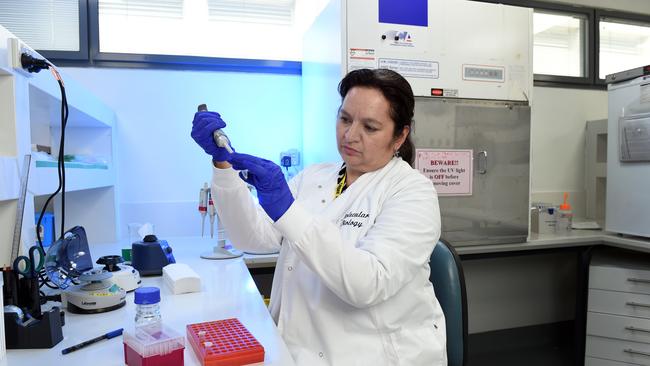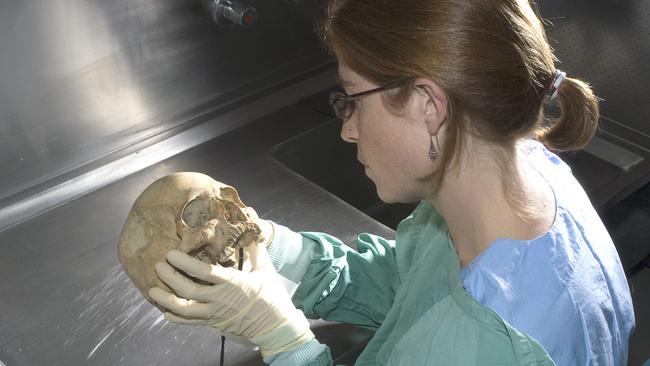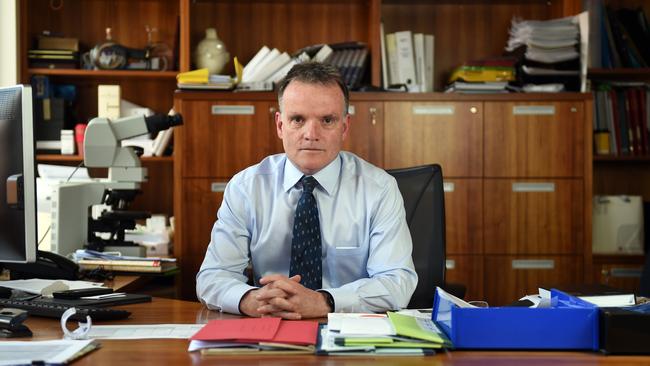MYSTERY surrounds the grisly discovery of bones at a beach and home in Geelong’s north. Chad Van Estrop goes behind the curtain at the state’s forensic institute to peek at the intriguing work that aims to identify these bones.
FOR more than three years a simple question has gone unanswered; who does the skull found at North Shore in June 2016 belong to?
Scientists at the Victorian Institute of Forensic Medicine (VIFM) have so far narrowed it to a caucasian male aged in his late 20s. But efforts to identify the man have stalled in the past year.
While the mystery has intrigued, another case was added to the mix in September.
Bones — believed to include a femur, pelvis, and skull with hair attached — were found in Marnoo Ct, Norlane.
This week police revealed they are waiting on the result of forensic testing on the bones. The Advertiser has been told they are human.
But the force has been tight lipped about what information has been extracted from the bones since they were handed to VIFM in Southbank.

WHEN human remains arrive at VIFM and identity is unknown, biological profiling begins.
Identity can be established through DNA, teeth and fingerprints, and profiles can be built from the ground up after bones are put through scanners delivering 3D results.
In cases where a body is taken to VIFM, toxicology tests for about 320 substances can be yield results overnight, and DNA testing on bones can deliver a match in as little as two days.
Ultimately identifying human remains is a jigsaw that joins information from pieces from multiple scientific disciplines.
One important part to the puzzle of matching bones to a human is DNA.
VIFM’s chief molecular biologist Dadna Hartiman and her team are at the frontline of DNA identification.
DNA from bones is extracted by pulverising a 5 to 10cm fragment into a powder using liquid nitrogen.
The powder is then spun at more than 10,000 revs per minute, and separated it into liquid and solids.
The remaining matter is then put through a filter that separates DNA from other information within cells.
“You can’t see the DNA but it’s in the solution,” Dr Hartiman says. “Bones might take two to three days to report on.”
Dr Hartiman says dense and compact bones like the femur tend to produce better sources of DNA.
While DNA phenotyping allows scientists to determine the hair and eye colour, and other personalised human features.

WHEN identify is in question, DNA from human remains is compared to about 350 samples at VIFM from family members of the long-term missing.
On the other side of the equation is 44 cold-cases where remains are yet to be identified.
“Our hope is to one day be able to identify these 44 individuals,” Dr Hartiman says.
She urges families of the long-term missing to provide police with DNA samples to increase the likelihood their loved ones are identified.
“Since 2010 we’ve been able to assist in two cold cases … to identify individuals … through the DNA matching database.”

One of those cases was a skull found northwest of Melbourne in 2014. After testing at VIFM it was found to belong to Mark Jansen, a 31-year-old father of two who disappeared in 1994.
Test on bones found at Norlane and North Shore have so far been unable to publicly link them to the region’s missing persons cases which include the kidnapping of Leopold man Paul Kingsbury, the disappearance of Bannockburn mum Lorrin Whitehead and a Barwon Heads light plane crash in which one of the occupants was never recovered.
Dr Hartiman says DNA extraction from skeletal remains can be compromised due to humic acid found in soil or corrosive substances in water.
But the team at VIFM through persistence have identified the remains of Victorian bushranger Ned Kelly and victims of the Black Saturday bushfires.
To prevent contamination anyone who enters VIFM’s DNA testing lab must provide their own DNA sample.

WHEN the coroner is required to take over bone finds, VIFM’s head of identification services and anthropology Soren Blau and her team who deal with about 100 cases a year go to work.
First they establish if the remains are human then, their goal is to provide information on ancestry, sex, height and age.
“The skull and the lower jaw … are extremely helpful as is the pelvis … that will give you information if the individual is male or female,” Associate Professor Blau said.
“The measures of the heads of the (upper arm, forearm and lower leg bones) can be useful to estimate a sex of person.”
Age ranges of adult bones can be provided in a five-to-ten-year bracket. Narrower estimations can be provided for juvenile bones.
When a skull is found, the level of teeth eruption is also used to determine the age of the individual.
Ms Blau says bone analyses can be used to determine injuries sustained from blunt force trauma, gunshots, if an individual has been stabbed and if injuries were sustained before death.
She says bones exposed to salt water or fire provide challenges to extracting DNA.
Ms Blau says tests at VIFM on unidentified human remains provide police a snapshot to compare to their database of missing people.
“The analysis of the skeleton is like a triaging process.”
VIFM BY THE NUMBERS
- 7000 cases annually, about half from natural cause deaths
- Up to 18 cases a day
- 15 pathologists
- 60 per cent of Black Saturday victims identified through dental comparisons
- About 40 cases of unidentified human bones
- 80 tissue donors per year
- Set up in 1988 in response to the Lindy Chamberlain trial

TV actor turned terrorist walks free from jail
An actor who was arrested and convicted as part of Australia’s largest terrorism operation is a free man after serving over 18 years.
Judge scolds AFP over ankle bracelets
A surprising argument about electronic monitoring used by the AFP to deny people bail has been lambasted in court.